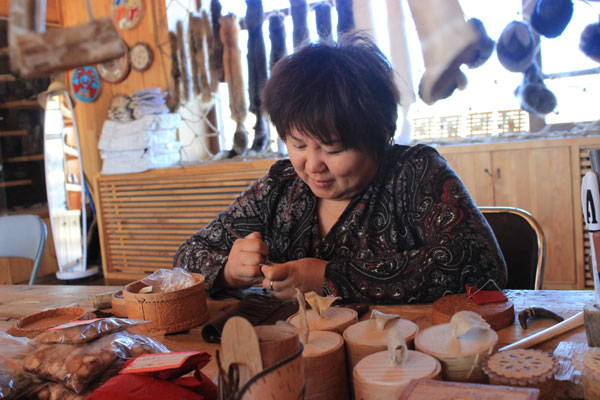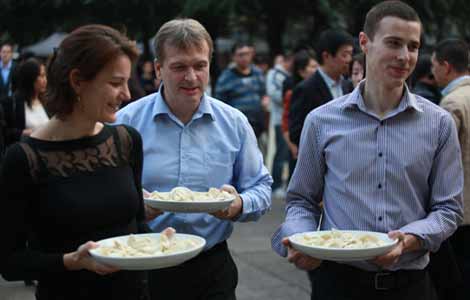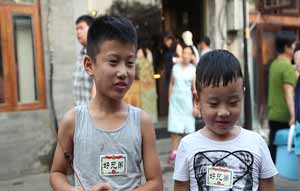Last of the reindeer hunters
Updated: 2013-10-15 07:35
(China Daily)
|
||||||||
New ways to live
According to Yu, Aoluguya township began to develop tourism in 2007 as a supplement to reindeer husbandry. A year later a 38-sq-m attic, was added to every cabin in the township, which are decorated in Scandinavian style. More than 20,000 tourists are attracted during the peak season between June and September. While 22 families have turned their dwellings into home-style inns, another 20 have opened stores selling local specialties.
 |
|
Dekli, one of the best-known artisans, makes Ewenki decorations in Aoluguya. Wang Kaihao / China Daily |
Bulina, 28, opened her inn in 2012, and has earned 20,000 yuan ($3,300) so far. The 28-year-old also works in a reindeer husbandry park nearby for five months each year for a monthly salary of 1,500 yuan.
"In the first class in college, the professor asked us to write down our post-graduation plans," she smiled. "Everyone wrote about their ambitious goals, but my answer was that I would be going back home.
"Aoluguya has such a small population. If all of us choose to leave, what will happen to my hometown?" She stared down at the 1-year-old child in her arms; "I dare not guess whether my daughter will move away, but I will respect her choice."
As the nearest hunting station to the township, Xiao's cabin has become a hot tourist destination, earning him up to 100,000 yuan a year. The local tourism bureau spends 10,000 yuan on each family that still raises deer in the mountains, equipping them with tents and basic facilities to allow tourists to stay in the forest overnight. Many people are introduced to Xiao's services via ads on the Internet, which also promote his business selling antler velvet.
Xiao has erected several teepee-like Ewenki tents, made of birch bark, at the station, but they are only used to illustrate daily life in the olden days to tourists.
A large-scale musical Aoluguya raised the profile of this oft-forgotten corner of China when it debuted in Beijing in 2010. Aoluguya township joined the Association of World Reindeer Herders in 2008, making China the ninth reindeer-husbandry country to join the organization. The fifth quadrennial World Reindeer Herders' Congress was held in the township in July, providing the locals with an international profile.
According to the Aoluguya Declaration, the final resolution made by the congress, reindeer husbandry has been threatened and is disappearing in a number of areas close to the Arctic Circle. It described the situation as "still critical and requiring urgent attention". The association also plans a series of international exchange programs for young Ewenki reindeer herders from China, and has proposed helping them to visit Russia to revitalize relationships.
"We're coordinating with our foreign allies to avoid inbreeding by introducing new reindeer breeds," said Yu. "This small place is getting closer to the big world."
Aoluguya township has even hosted Christmas celebrations for a number of years under the name "China's Home of Santa Claus", hosting parties and reindeer sled races to attract more attention during the long slow winter tourist season, but the event is currently suspended as a new and detailed development plan is formulated. The township also aims to hold an annual sledding competition to widen the brand's influence.
"If we can fully use the tough winter here, our tourism will have another scenario," said Yang Limin, Party chief of Genhe, bemoaning the decline of forestry operations that has dragged Genhe, one of the richest places in Inner Mongolia during the 1980s, from wealth to poverty. The city is now one of poorest county-level administrative districts in the autonomous region.
"We should thank the people of Aoluguya. They have made a great contribution to the development of society by sticking to their homeland and safeguarding this cold forest, a place that was once considered uninhabitable for human beings."

 Storm swamps car insurance firms
Storm swamps car insurance firms
 Smartphone firm rockets into the US
Smartphone firm rockets into the US
 3 US economists share 2013 Nobel Prize in Economics
3 US economists share 2013 Nobel Prize in Economics
 Canton Fair to promote yuan use
Canton Fair to promote yuan use
 Vintage cars gather in downtown Beijing
Vintage cars gather in downtown Beijing
 Riding the wave of big bargain buy-ups
Riding the wave of big bargain buy-ups
 Senate leads hunt for shutdown and debt deal
Senate leads hunt for shutdown and debt deal
 Chinese education for Thai students
Chinese education for Thai students
Most Viewed
Editor's Picks

|

|

|

|

|

|
Today's Top News
All 86 tourists evacuated from Mount Qomolangma
Obama hopeful as meeting nears with lawmakers
Canton Fair to promote yuan use
Over 380 detained in Moscow riot
86 trapped at Mount Qomolangma camp amid snow
Going green can make good money sense
Window cracks for progress in Iran
Senate leader 'confident' fiscal crisis can be averted
US Weekly

|

|







